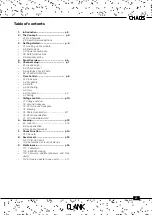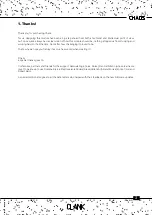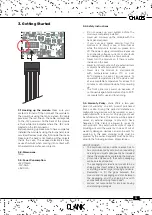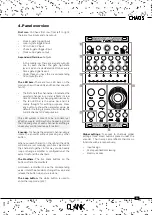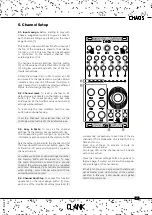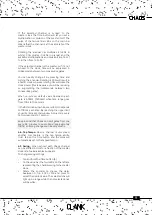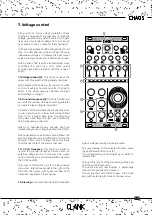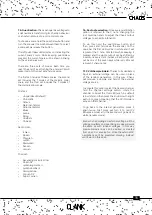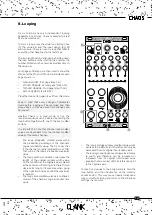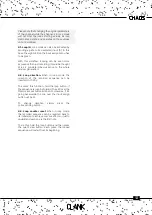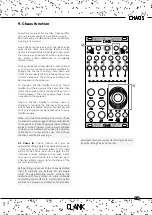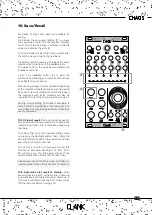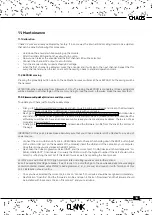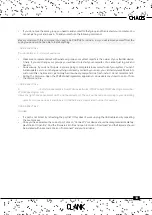
8
6. Time Control
At its core, Chaos is composed of six channels
of clock generators [2] and all the channels can
be individually synced to the master clock or be
completely time independent.
To change this press the
Channel settings
button
[6] and rotate the encoder to select
clock in
LED
[1]. When green, it will be linked to the master
clock, when white, it will be unsynced and time
independent.
6.1. Clock sync [1].
If no signal is applied to the
Clock input
[1], Channel 1 will be the master clock.
To sync Chaos to an external clock source, send a
50% pulse width gate to
Clock input
[1]. A trigger
or a LFO may be also inserted.
When synced to an external clock source the
start’n’stop function is also activated . Chaos
brain, indeed, always awaits a trigger to create
the next step, so if you interrupt the clock signal,
it will stop. Otherwise it will start again, as soon as
another pulse is applied.
6.2. Probability [3]
. This function is a sort of coin
toss to declare if a gate of the selected channel
will fire or not.
Changing the
probability
value will reduce its
possibility to happen. The range of value is from
0% to 100%.
If you’re using channel 1 as the master clock,
changing its
probability
will affect its gate output
but not the master clock data stream.
Turn it to zero will also mute a channel.
6.3. Width [5]
. The length of a gate’s duty cycle
expressed in percentage. Range is from 1% to
100% (fully open).
6.4. Racheting [5].
This function allows to multiply
the number of emitted gates for each step.
This means that inside the same time lenght
more than one gate can be played and their time
distance will be a fraction of the initial interval.
To access this function, tap and hold the
width
button
[5] , on the
value bar
8 white LEDs will
indicate all the the possible divisions.
The orange LED will show wich ratio is selected,
2
1
3
4
5
rotate the encoder to change it beetwen 1:1 and
8:1.
Gate width will be effected at the same manner,
meaning that each dot on the value bar will also
halve the gate lenght.
When used in conjuction with Probability, each
gate output will be influenced independetly even
inside the same step. This can be used to create
interesting rythimic fluctuations while keeping the
same CV output. (i.e. different strokes with the
same note)
6.5. Time [4]
is expressed in two different ways,
depending on if a channel is synced or not:
6
7
Summary of Contents for CLANK
Page 1: ...Chaos manual v 1 1...


